Narmada River
The Narmada River, also called the Rewa and previously also known as Nerbudda,[2] is a river in central India after the Godavari, and the Krishna. It is also known as "Life Line of Madhya Pradesh and Gujarat" for its huge contribution to the state of Madhya pradesh and Gujarat in many ways. Narmada rises from Amarkantak Plateau near Anuppur district Madhya Pradesh. It forms the traditional boundary between North India and South India and flows westwards over a length of 1,312 km (815.2 mi) before draining through the Gulf of Khambhat into the Arabian Sea, 30 km (18.6 mi) west of Bharuch city of Gujarat.[3][4]
| Narmada | |
|---|---|
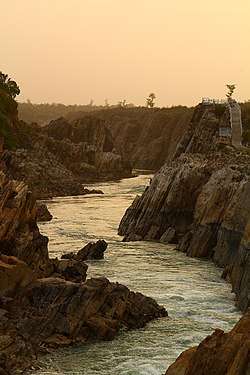 At Bhedaghat in Jabalpur, India | |
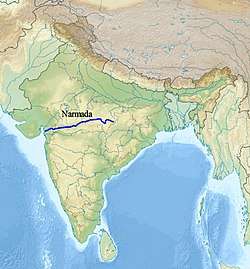 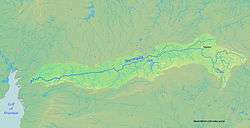 Maps showing the course of the Narmada, selected tributaries, and the approximate extent of its drainage area | |
| Location | |
| Country | India |
| State | Madhya Pradesh, Maharashtra, Gujarat |
| City | Jabalpur, Dindori, Narsinghpur Harda, Mandhata, Barwani, Omkareshwar, Barwaha, Maheshwar, Mandla, Bharuch, Rajpipla, Sinor (Vadodara District), Dabhoi (Vadodara District), Karjan (Vadodara District), Dharampuri |
| Physical characteristics | |
| Source | Narmada Kund |
| • location | Vindhyachal Parvat Amarkantak Plateau, Anuppur district, Central India, Madhya Pradesh |
| • coordinates | 22°40′0″N 81°45′0″E |
| • elevation | 1,048 m (3,438 ft) |
| Mouth | Gulf of Khambhat (Arabian Sea) |
• location | Bharuch District, Gujarat |
• coordinates | 21°39′3.77″N 72°48′42.8″E |
• elevation | 0 m (0 ft) |
| Length | 1,312 km (815 mi)approx. |
| Discharge | |
| • average | 1,447 m3/s (51,100 cu ft/s) |
| Discharge | |
| • location | Garudeshwar[1] |
| • average | 1,216 m3/s (42,900 cu ft/s) |
| • minimum | 10 m3/s (350 cu ft/s) |
| • maximum | 11,246 m3/s (397,100 cu ft/s) |
| Basin features | |
| Tributaries | |
| • left | Burhner River, Banjar River, Sher River, Shakkar River, Dudhi River, Tawa River, Ganjal River, Chhota Tawa River, Kaveri River, Kundi River, Goi River, Karjan River |
| • right | Hiran River, Tendoni River, Choral River, Kolar River, Man River, Uri River, Hatni River, Orsang River |
It is one of only three major rivers in peninsular India that run from east to west (longest west flowing river), along with the Tapti River and the Mahi River. It is one of the rivers in India that flows in a rift valley, flowing west between the Satpura and Vindhya ranges. The other rivers which flow through rift valley include Damodar River in Chota Nagpur Plateau and Tapti. The Tapti River and Mahi River also flow through rift valleys, but between different ranges. It flows through the states of Madhya Pradesh (1,077 km (669.2 mi)), and Maharashtra, (74 km (46.0 mi)),(39 km (24.2 mi)) (actually along the border between Madhya Pradesh and Maharashtra (39 km (24.2 mi)) and then the border between Maharastra and Gujarat (74 km (46.0 mi)) and in Gujarat (161 km (100.0 mi)).[5]
The Periplus Maris Erythraei (c. 80 AD) calls it the Nammadus,[6] and the British Raj called it the Nerbudda or Narbada.[7] Narmada' is a Sanskrit word meaning "the Giver of Pleasure".[8]
River regime
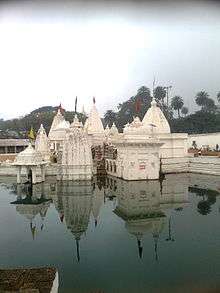
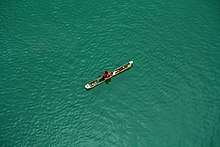
The source of the Narmada is a small reservoir, known as the Narmada Kund, located at Amarkantak on the Amarkantak Plateau[9][5] in the Anuppur District, Shahdol zone of eastern Madhya Pradesh.[10] The river descends from Sonmud, then falls over a cliff as Kapildhara waterfall and meanders in the hills, flowing through a tortuous course crossing the rocks and islands up to the ruined palace of Ramnagar. Between Ramnagar and Mandla, (25 km (15.5 mi)), further southeast, the course is comparatively straight with deep water devoid of rocky obstacles. The Banger joins from the left. The river then runs north–west in a narrow loop towards Jabalpur. Close to this city, after a fall of some (9 m (29.5 ft)), called the Dhuandhara, the fall of mist, it flows for (3 km (1.9 mi)), in a deep narrow channel through the magnesium limestone and basalt rocks called the Marble Rocks; from a width of about 90 m (295.3 ft), above, it is compressed in this channel of (18 m (59.1 ft)), only. Beyond this point up to its meeting the Arabian Sea, the Narmada enters three narrow valleys between the Vindhya scarps in the north and the Satpura range in the South. The southern extension of the valley is wider at most places. These three valley sections are separated by the closely approaching line of the scarps and the Satpura hills.
.jpg)
Emerging from the Marble Rocks the river enters its first fertile basin, which extends about 320 km (198.8 mi), with an average width of 35 km (21.7 mi), in the south. In the north, the valley is limited to the Barna–Bareli plain terminating at Barkhara Hills opposite Hoshangabad. However, the hills again recede in the Kannod plains. The banks are about (12 m (39.4 ft)) high. It is in the first valley of the Narmada that many of its important tributaries from the south join it and bring the waters of the northern slopes of the Satpura Hills.[2] Among them are: the Sher, the Shakkar, the Dudhi, the Tawa (biggest tributary) and the Ganjal. The Hiran, the Barna, the Choral, the Karam and the Lohar are the important tributaries joining from the north.
Below Handia and Nemawar to Hiran fall (the deer's leap), the river is approached by hills from both sides. In this stretch the character of the river is varied. The Omkareshwar island, sacred to the Lord Shiva, is the most important river island in Madhya Pradesh. At first, the descent is rapid and the stream, quickening in pace, rushes over a barrier of rocks. The Sikta and the Kaveri join it below the Khandwa plain. At two points, at Mandhar, about 40 km (24.9 mi) below Nemawar, and Dadrai, 40 km (24.9 mi) further down near Punasa, the river falls over a height of about 12 m (39.4 ft).
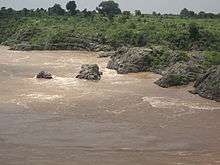
A few kilometres further down near Bareli and the crossing ghat of the Agra to Mumbai road, National Highway 3, the Narmada enters the Mandleshwar plain, the second basin about 180 km (111.8 mi) long and 65 km (40.4 mi) wide in the south. The northern strip of the basin is only 25 km (15.5 mi). The second valley section is broken only by Saheshwar Dhara fall. The early course of about 125 km (77.7 mi) up to Markari falls is met with a succession of cataracts and rapids from the elevated table land of Malwa to the low level of Gujarat plain. Towards the west of this basin, the hills draw very close but soon dwindle down.
Below Makrai, the river flows between Vadodara district and Narmada district and then meanders through the rich plain of Bharuch district of Gujarat state. The banks are high between the layers of old alluvial deposits, hardened mud, gravels of nodular limestone and sand. The width of the river spans from about 1.5 km (0.9 mi) at Makrai to 3 km (1.9 mi) near Bharuch and to an estuary of 21 km (13.0 mi) at the Gulf of Cambay. An old channel of the river, 1 km (0.6 mi) to 2 km (1.2 mi) south from the present one, is very clear below Bharuch. The Karanjan and the Orsing are the most important tributaries in the original course. The former joins at Rundh and the latter at Vyas in Vadodara district of Gujarat, opposite each other and form a Triveni (confluence of three rivers) on the Narmada. The Amaravati and the Bhukhi are other tributaries of significance. Opposite the mouth of the Bhukhi is a large drift called Alia Bet or Kadaria Bet.
The tidal rise is felt up to 32 km (19.9 mi) above Bharuch, where the neap tides rise to about a metre and spring tide 3.5 m (11.5 ft). The river is navigable for vessels of the burthen of 95 tonnes (i.e., 380 Bombay candies) up to Bharuch and for vessels up to 35 tonnes (140 Bombay candies) up to Shamlapitha or Ghangdia. The small vessels (10 tonnes) voyage up to Tilakawada in Gujarat. There are sand bases and shoals at mouth and at Bharuch. The nearby island of Kabirvad, in the Narmada River, features a gigantic Banyan tree, which covers 10,000 square metres (2.5 acres).[11]
Narmada basin
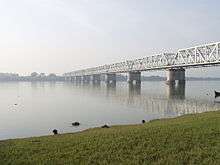
The Narmada basin, hemmed between Vindya and Satpura ranges, extends over an area of 98,796 km2 (38,145.3 sq mi) and lies between east longitudes 72 degrees 32' to 81 degrees 45' and north latitudes 21 degrees 20' to 23 degrees 45' lying on the northern extremity of the Deccan Plateau. The basin covers large areas in the states of Madhya Pradesh (82%), Gujarat (12%) and a comparatively smaller area (4%) in Maharashtra and in (2%) in Chhattisgarh. In the river course of 1,312 km (815.2 mi) explained above, there are 41 tributaries, out of which 22 are from the Satpura range and the rest on the right bank are from the Vindhya range.[5] Dhupgarh (1,350 m), near Pachmarhi is the highest point of the Narmada basin.[12]
The basin has five well defined physiographic regions. They are:(1) The upper hilly areas covering the districts of Shahdol, Mandla, Durg, Balaghat and Seoni, (2) The upper plains covering the districts of Jabalpur, Narsinghpur, Sagar, Damoh, Chhindwara, Hosangabad, Betul, Raisen and Sehore, (3) The middle plains covering the districts of Khandwa, part of Khargone, Dewas, Indore and Dhar, (4) The lower hilly areas covering part of the west Nimar, Jhabua, Dhulia, Narmada and parts of Vadodara, and (5) the lower plains covering mainly the districts of Narmada, Bharuch, and parts of Vadodara district. The hill regions are well forested. The upper, middle and lower plains are broad and fertile areas, well suited for cultivation. The Narmada basin mainly consists of black soils. The coastal plains in Gujarat are composed of alluvial clays with a layer of black soils on the surface.[13]
The valley experiences extremes of hydrometeorological and climatic conditions with the upper catchment having an annual precipitation in the range of 1,000 mm (3.3 ft) to 1,850 mm (6.1 ft) and with half or even less than half in its lower regions (650 mm (2.1 ft)–750 mm (2.5 ft)); the diversity of vegetation from lush green in the upper region to dry deciduous teak forest vegetation in the lower region is testimony to this feature.[5]
The Irrigation Commission (1972) identified the Narmada basin in Madhya Pradesh as drought affected and a large part of North Gujarat, Saurashtra and Kutch as semi-arid or arid scarcity regions on account of extreme unreliability of rainfall, rendering them 'chronically' drought-prone and subject to serious drinking water problems.
Geology
The Narmada Valley is a graben, a layered block of the Earth's crust that dropped down relative to the blocks on either side due to ancient spreading of the Earth's crust. Two normal faults, known as the Narmada North fault and Narmada South fault, parallel to the river's course, and mark the boundary between the Narmada block and the Vindhya and Satpura blocks or Horsts which rose relative to the Narmada Graben. The Narmada's watershed includes the northern slopes of the Satpuras, and the steep southern slope of the Vindhyas, but not the Vindhyan tableland, the streams from which flow into the Ganges and Yamuna.[2] The Narmada valley is considered extremely important for palaeontological studies in India. Several dinosaur fossils have been found in the area including Titanosaurus indicus found in 1877 by Richard Lydekker and the recently discovered Rajasaurus narmadensis.
Significance in Hinduism
| Narmada | |
|---|---|
Goddess of the Narmada river | |
| Affiliation | Devi, River goddess |
| Abode | Kailash and Amarkantak parvat |
| Mount | Makara |
| Personal information | |
| Parents |
|
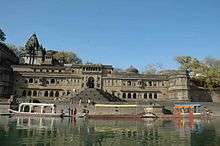
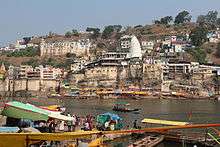
To Hindus the Narmada is one of the seven holy rivers of India; the other six being Ganges, Yamuna, Godavari, Saraswati, Sindhu, and Kaveri. It is believed that a dip in any of these seven rivers washes one's sins away. According to a legend, the river Ganges, polluted by millions of people bathing in it, assumes the form of a black cow and comes to the Narmada to bathe and cleanse itself in its holy waters.
The river was mentioned by Ptolemy in the second century AD as Namade[14] and by the author of the Periplus.[15][16] The Ramayana,[17] the Mahabharat, and the Puranas refer to it frequently. The Rewa Khand of Vayu Purana and the Rewa Khand of Skanda Purana are entirely devoted to the story of the birth and the importance of the river, and hence Narmada is also called the Rewa.
There are many fables about the origin of the Narmada. According to one of them, once Lord Shiva, the Destroyer of the Universe, meditated so hard that he started perspiring. Shiva's sweat accumulated in a tank and started flowing in the form of a river – the Narmada. Another legend has it that two teardrops that fell from the eyes of Lord Brahma, the creator of the universe, yielded two rivers – the Narmada and the Brahmaputra.[18]
All the pebbles rolling on its bed are said to take the shape of his emblem with the saying, "Narmada Ke Kanker utte Sankar" (a popular saying in the Hindi belt of India), which means that 'pebble stones of Narmada get a personified form of Shiva'. These lingam shaped stones (cryptocrytalline quartz), called Banalinga also called (Banashivalingas) are much sought after for daily worship by the Hindus.[19] The Brihadeeswara Temple in Thanjavur, Tamil Nadu, constructed by Rajaraja Chola, has one of the biggest Banalingas. Adi Shankara met his guru Govinda Bhagavatpada on the banks of the river Narmada.
Narmada is also said to have been in love with the Sonbhadra, another river flowing on the Chota Nagpur Plateau. According to the Puranas, the Narmada is also called the Rewa, from its leaping motion (from the root 'rev') through its rocky bed.
Important religious places and Ghats along the course of the river, starting from its origin at Narmadakhund at Amarkantak hill, are a) the Amarkantak (in Sanskrit: Neck of Shiva) or Teertharaj (the King of Pilgrimages), b) Omkareshwar, Maheshwar, and Mahadeo temples, Nemawar Siddeshwar Mandir in the middle reach of the river – all named after Shiva, c) Chausath Yogini (sixty four yoginis) temple, d) Chaubis Avatar temple, e) and Bhrigu Rishi temple in Bharuch. The Narmada River is also worshipped as mother goddess by Narmadeeya Brahmins.
The importance of the Narmada River as sacred is testified by the fact that the pilgrims perform a holy pilgrimage of a parikrama or circumambulation of the river.[20] The Narmada Parikrama, as it is called, is considered to be a meritorious act that a pilgrim can undertake.[2] Many sadhus and pilgrims walk on foot from the Arabian Sea at Bharuch in Gujarat, along the river, to the source in Maikal Mountains (Amarkantak hills) in Madhya Pradesh and back along the opposite bank of the river. It is a 2,600-kilometre (1,600 mi) walk.[21] The spiritual journey is usually taken for 3 years, 3 months and 13 days and the pilgrims are stipulated not to cross the river at any point of time.[22] Important towns of interest in the valley are Jabalpur, Barwani, Hoshangabad, Harda, Narmada Nagar, Omkareshwar, Dewas (Nemavar, Kity, Pipri), Mandla and Maheshwar in Madhya Pradesh, and Rajpipla and Bharuch in Gujarat. Some places of historical interest are Joga Ka Quilla, Chhatri of Baji Rao Peshwa and Bhimbetka, and among the falls are the Dugdhdhara, Dhardi falls, Bheraghat, Dhuandhara, Kapiladhara and Sahastradhara.[23]
Facts of the valley
In Indian history, Kannada emperor from cholas dynasty Pulakeshin II is said to have defeated emperor Harshavardhana of Kannauj on the banks of Narmada.
The valley is famous for the gorgeous Maheshwari saris, which are handwoven; comfortable in warm and cold weather, dressy and yet light; these saris have a dedicated, select following among Indian women.
Forests and sanctuaries
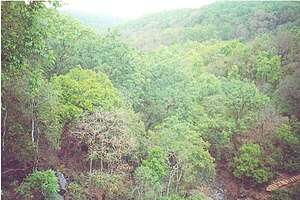
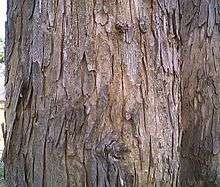
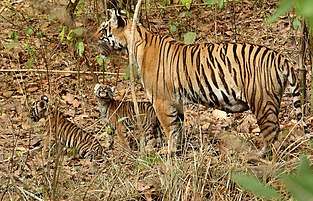
Teak and India's best hardwood forests are found in the Narmada River basin and they are much older than the ones in the Himalayas. The lower Narmada River Valley and the surrounding uplands, covering an area of169,900 km2 (65,598.8 sq mi) consists of dry deciduous forests. The ecoregion lies between moister forests to the northeast, southeast, and southwest, which receive greater rainfall from the southeast monsoon, and the drier forests and scrublands of the Deccan to the south and Malwa and Gujarat to the west and northwest. The natural vegetation of the region is a three–tiered forest. Tectona grandis is the dominant canopy tree, in association with Diospyros melanoxylon, Dhaora (Anogeissus latifolia), Lagerstroemia parviflora, Terminalia tomentosa, Lannea coromandelica, Hardwickia binata and Boswellia serrata. Riparian areas along the regions' rivers and streams, which receive year– round water, are home to moist evergreen forests, whose dominant tree species are Terminalia arjuna, Syzygium cumini (Jambul), Syzygium Heyneanum, Salix tetrasperma, Homonoia riparia, and Vitex negundo.
The ecoregion is home to 76 species of mammals and to 276 bird species, none of which are endemic. About 30% of the ecoregion is covered in relatively intact vegetation. The ecoregion includes some large blocks of habitat in the Vindhya and Satpura ranges. About 5% of the ecoregion lies within protected areas, including Bandhavgarh, Panna, and Sanjay National Parks.
Some of the important national parks and wild life sanctuaries in the valley are the following-: Kanha National Park located in the upper reaches of Narmada, about 18 km (11.2 mi) from Mandla, boasts of several wild animals including the Tiger. Two tributaries of Narmada, namely, Hallon and Banjar, flow through this park. It is one of the best National Parks of Asia, which has been described vividly by Rudyard Kipling in his famous creation The Jungle Book.
Satpura National Park, set up in 1981, is located in Hoshangabad district of Madhya Pradesh. Its name is derived from Satpura hill ranges (Mahadeo hills) and covers an area of 524 km2 (202.3 sq mi) and along with the adjoining Bori and Panchmarhi Sanctuaries, provides 1,427 km2 (551.0 sq mi) of unique central Indian Highland ecosystem. Satpura National Park, being part of a unique ecosystem, is very rich in biodiversity. The fauna comprises tiger, leopard, sambar, chital, bhedki, nilgai, four-horned antelope, chinkara, gaur, wild boar, wild dog, sloth bear, black buck, fox, porcupine, flying squirrel, mouse deer, Indian giant squirrel. There are a variety of birds. Hornbill and peafowl are the common birds. The flora of the national park consists of mainly sal, teak, tendu, aonla, mahua, bael, bamboo, and a variety of grasses and medicinal plants.
Forest areas outside protected areas are also quite rich in floral and faunal diversity.
Mandla Plant Fossils National Park, Dindori National fossils park Ghughuya is situated in Dindori district of Madhya Pradesh in India. This national park has plants in fossil form that existed in India anywhere between 40 million and 150 million years ago spread over seven villages of Mandla District (Ghuguwa, Umaria, Deorakhurd, Barbaspur, Chanti-hills, Chargaon and Deori Kohani). The Mandla Plant Fossils National Park is an area that spreads over 274,100 m2 (2,950,387.8 sq ft). Such fossils are found in three other villages of the district also, but they lie outside the national park.
One theory is that the area in which the fossils are located, i.e., the Narmada Valley near Mandla, was actually a deep inundation of the sea into peninsular India till the Post- Cambrian Tertiary age, about 40 million years ago. This means that Narmada was a very short river which terminated in the inland sea above Mandla, and that the recession of the sea caused geological disturbances, which created the present rift valley through which the Narmada River and Tapti River flow in their present journey to the Arabian Sea. All this, however, is speculation and conjecture because it is only recently that an interest has developed in the fossils of Mandla and detailed scientific studies are still wanting.
The Pachmarhi Biosphere Reserve covers part of three civil districts viz., Hoshangabad, Betul and Chhindwara of Madhya Pradesh. The total area is 4,926.28 km2 (1,902.0 sq mi). It envelops three wildlife conservation units viz., Bori Sanctuary (518.00 km²), Satpura National Park (524.37 km2 (202.5 sq mi)), and Pachmarhi Sanctuary (461.37 km2 (178.1 sq mi)). Satpura National Park comprises the core zone and the remaining area of 4,501.91 km2 (1,738.2 sq mi)), surrounding the core zone serves as buffer zone. The area comprises 511 villages. The area exhibits variety of geological rock and soil formations. There is a wide spectrum of floral and faunal features that occupy the Satpura conservation area. It is one of the oldest forest reserves, which has an established tradition of scientific management of forests. It constitutes a large contiguous forest block that harbours a community of plant and animal species typical of the central highland region.[24]
Apart from the above national parks, there are also a number of natural preserves such as the Amarkantak, the Bagh Caves and the Bhedaghat. In compliance of the Environmental Action Plan for the Narmadasagar and Omkareswar HEPs, as per the recommendations of the Wildlife Institute of India three new protected areas may be created, which are, a) the Narmada National Park (496.70 km2), b) the Surmanya Sanctuary (126.67 km2) and c) Omkareshwar Sanctuary (119.96 km2) comprising a total area of 788.57 km2 (304.47 sq mi).[25]
Shoolpaneshwar Sanctuary in Gujarat, near the Sardar Sarovar dam site, previously called the Dumkal Sloth Bear Sanctuary (old sanctuary has been expanded four times) now covers an area of about 607 km2 (234.4 sq mi), comprises a major watershed feeding the Sardar Sarovar and Karjan reservoir (on the Karjan River, a tributary of Narmada in Gujarat). It is the habitat of mammals and a variety of birds, including eagles and hawks.[26][27]
Anthropological and archaeological sites
The development of the Narmadā river has led to the inundation of some archaeological and architectural sites. The Department of Archaeology, Museums and Archives, Government of Madhya Pradesh, undertook rescue excavations in response, and transplanted a number of temples.[28] An attempt to comprehensively list and publish lost sites has been undertaken by Jürgen Neuss.[29]
Narmada river development (NRD)
The Narmada river has a huge water resources potential, as much as 33,210,000 acre feet (40.96 km3) of average annual flow (more than 90% of this flow occurring during the monsoon months of June – September), which according to estimates is greater than the combined annual flows of the Ravi, Beas and the Sutlej rivers, which feed the Indus basin. The 75% dependable flow is 28,000,000 acre feet (35 km3).[30]
Early background and dispute
Investigations for harnessing the Narmada waters started around the time of independence, when Central Waterways, Irrigation and Navigation Commission (CWINC) identified several storage schemes and in 1948 the Khosla Committee prioritised the proposals and named Tawa, Bargi, Punasa and Bharuch projects (the last three on the main stem of the river) for preparation of reports.[31] The reports were ready by 1963. A parallel study of hydropower potential identified 16 sites with a potential of 1300 MW. While the project in Gujarat, the Baruch Weir project (for which Jawaharlal Nehru laid the foundation stone in 1961) went through a series of modifications and improvements with a reformed scheme at Navagam village to extend benefits up to the Rann of Kutch, following the bifurcation of the erstwhile Bombay state into Maharashtra and Gujarat states and Gujarat's intent to raise the height of the dam at Navagam to maximise storage benefits at the cost of submergence of potential hydropower sites in Maharashtra and Madhya Pradesh, there was a dispute between the states. It resulted in an impasse in the implementation of the agreed projects at Navagam in Gujarat, Punasa in Madhya Pradesh and Bargi Dam in Madhya Pradesh and power benefit sharing among the states; with Madhya Pradesh refusing to ratify the agreements. To break the logjam, a high level Committee was appointed by the Government of India (GOI) in September 1964. In 1965, the Committee prepared a Master Plan for the basin, which involved construction of 12 major projects in MP and the Navagam Dam in Gujarat. It provided priority to irrigation over power; irrigation of 2,630 square kilometres (1,020 sq mi) in MP, 400 square kilometres (150 sq mi) in Maharashtra, 460 square kilometres (180 sq mi) in Gujarat and 4,000 square kilometres (1,500 sq mi) in Rajasthan. The storages it recommended in MP involved Bargi, Tawa and Narmadasagar (Punasa) while its proposed Navagam high dam would submerge the hydelpower project sites of Jalasindhi (in Maharashtra) and Harinphal (MP) but without any more submergence than would be caused by the three dams if separately constructed. Gujarat endorsed the proposal, but Maharashtra was not willing to go by it. After intense parleys failed to resolve the problem, the GOI decided to set up the Narmada Water Disputes Tribunal (NWDT) in 1969 under the Interstate River Water Disputes Act 1956 to adjudicate on the dispute relating to sharing of water of the interstate Narmada and its valley.
Tribunal award.[32]
After ten years of deliberations, the Narmada Water Disputes Tribunal (NWDT) gave its award in December 1979. The NWDT, considering the development of the water resources of the basin as a whole, gave its award, allocating share of water and Hydro Power of the Sardar Sarovar Project.
The Tribunal's final order determined the utilisable quantum of Narmada waters to be 27,000,000 acre feet (33 km3) at 75% dependability and allocated it to the four states, as in Table below, including share of power benefits. It also stipulated the share of water when utilisable flow was in excess of 28,000,000 acre feet (35 km3). The Navagam dam height was fixed at full reservoir level (FRL) 460 feet (140 m) with a maximum water level of EL feet. The Full Supply Level of the Navagam canal was fixed at 300 feet (91 m). The costsharing formula among the states and the consequent requirement of release of regulated releases from the Narmada Sagar dam by MP was also spelt out. The resettlement and rehabilitation package was also clearly specified with all costs to be borne by Gujarat for all resettlement and rehabilitation work of people affected in the three states and also for relocating any ancient or historic monuments, places of worship or idols likely to suffer submergence.
| Party States | Allocated share of water | % share of power |
|---|---|---|
| Madhya Pradesh | 18,250,000 acre feet (22.51 km3) | 57 |
| Gujarat | 9,000,000 acre feet (11 km3) | 16 |
| Maharashtra | 250,000 acre feet (0.31 km3) | 27 |
| Rajasthan | 500,000 acre feet (0.62 km3) | Nil |
| Total | 28,000,000 acre feet (35 km3) | 100 |
The uniqueness of this Award is that a non-riparian state – Rajasthan – has been allocated a share of Narmada waters, for meeting the water requirements of the drought prone districts of Barmer and Jalore, which have no other source of dependable water. The work on the project did not start soon since extensive studies were undertaken for project designing and with World Bank getting involved with funding studies and project costs (Loan agreement with GOI of $450 million was signed in May 1985), the Resettlement and Rehabilitation (R&R) package was substantially revised, over and above what was set in the NWDT, and environmental studies had to be undertaken, but the environmental and forest clearances for the projects from the newly formed Ministry of Environment and Forests (MoE&F) involved extensive interministerial and inter departmental discussions (within the central govt and with state governments) for a substantial period and it was only in June 1987 (almost 8 years after the NWDT award was given in December 1979) that the MoE&F gave a conditional approval to the Sardar Sarovar and Narmada Sagar Projects. The forest clearance was given in September 1987 for Sardar Sarovar only. The clearance also required the work to be done pari passu with the construction of the dams and the filling of the reservoir. In the meantime, the Narmada Control Authority (NCA), an inter-State Administrative Authority and the Sardar Sarovar Construction Advisory Committee (SSCAC) were set up in 1980 by the Govt. of India in compliance of the NWDT award; the former organisation was set up in December 1980 as body corporate with representatives from the four party states and India, as a machinery to implement the decisions and directions of the NWDT and the later organisation was set up in Sept. 1980 as a statutory body to ensure efficient, economical and timely execution of the Unit I (dam and appurtenant works) and Unit III (hydropower works) of the Sardar Sarovar Project (SSP). A Review Committee consisting of the Union Minister for Irrigation (now substituted by Union Minister for Water Resources) as its Chairperson and the Chief Ministers of Madhya Pradesh, Maharashtra, Gujarat and Rajasthan as its members is also in position to review the decisions of the NCA and the SSCAC, as required. For monitoring and implementation of various environmental activities effectively, independent machinery of the Environment Sub-Group is functioning since Nov.1987 under NCA. Similarly, for monitoring the progress of the resettlement and rehabilitation of project affected people, R&R subgroup is also functioning under the NCA. At the state level, Sardar Sarovar Narmada Nigam Limited (SSNL) in Gujarat has the mandate to implement and manage the Sardar Sarovar multipurpose project. In Madhya Pradesh, the Narmada Valley Development Authority (NVDA) is vested the responsibility for implementation of the projects.
The overall plan for development ultimately conceived involves 30 major dams including Sardar Sarovar (21 irrigation, 5 hydropower, and 4 multipurpose), some 135 medium dams, and over three minor dams in M.P along the main stem of the river and its 41 tributaries to utilise its allocated share of 18,250,000 acre feet (22.51 km3) before 2025 (within 45 years of the NWDT award). In addition to power generation and irrigation within the basin, water was allocated for domestic and industrial water uses and for multipurpose transbasin diversions to Son River and Tons River basins in eastern MP, drought prone areas of Saurashtra, Kutch, northern mainland in Gujarat, and southern Rajasthan. Irrigation benefits to the extent of about 40,000 square kilometres (15,000 sq mi) to 50,000 square kilometres (19,000 sq mi) (of drought prone and scarcity areas) and power generation of 2,600 MW were also envisaged. Thus, the Narmada River development is envisaged as a multi state program for development of hydropower and irrigation dams and their associated irrigation networks. In 1961, the original project envisaged irrigation of almost 2 million acres (8,100 km2) in West India at a cost of $100 million. By 2011, it had escalated to $3 billion.
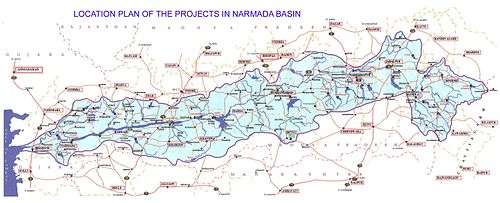
Even though the tribunal award resolved the initial issue of water sharing, but the height of dam, benefit sharing and the mode of settlement of affected people caused serious difficulties in implementation, particularly of the Sardar Sarovar dam (the terminal dam on the river). Affected people agitated under the banner of the dedicated NGO, The Narmada Bachao Andolan (NBA). The NBA followed up by Public Interest Litigation (PIL) in the Supreme Court of India. The NBA questioned the benefits claimed from the major projects, challenged the resettlement and rehabilitation packages for project affected people of the reservoir submergence and canal affected zones and its implementation. It also rejected the environmental impact assessments made and the remedial actions taken by the project authorities. The challenge created worldwide attention to the major development activity planned in the valley. It urged the World Bank to withdraw from the project and the intense worldwide pressure resulted in the Bank mounting an Independent Review Mission (IRM) called the Morse Mission to review the SSP. However, the IRM's report was neither accepted by the Government of India or the World Bank. Finally Government of India decided to terminate further drawing from a remaining $180 million World Bank credit from the Bank with the firm resolution that the project would be completed within the national resources.
The Supreme Court has also deliberated on this issue for several years but finally upheld the Tribunal Award and allowed the construction to proceed, subject to conditions. The Court introduced a mechanism to monitor the progress of resettlement pari passu with the raising of the height of the dam through Grievance Redressal Authorities (GRA) in each of the party states. The court's decision referred in this document, given in the year 2000, after 7 years of deliberations, has paved the way for completing the project to attain full envisaged benefits.[33]
The Supreme Court judgement was by two of a three judge panel. The third judge, SP Bharucha, dissented with the two other judges' verdict[34]
Indirasagar Dam

The Indira Sagar Project (ISP) at Punasa is one of the 30 major projects proposed in the Narmada basin with the largest storage capacity in the country. The project is located near Punasa village, in Khandwa District, Madhya Pradesh. This Multipurpose River Valley Project envisages construction of a concrete gravity dam, 653 metres (2,142 ft) long and 92 metres (302 ft) high with gross storage capacity of the reservoir of 12.22 km3 (9,910,000 acre⋅ft) and live storage of 9.75 km3 (7,900,000 acre⋅ft) to provide an annual irrigation potential of 1,690 km2 (650 sq mi) and a generation of 1000 MW of hydropower. The project also ensures supply of 60,000 acre⋅ft (74,000,000 m3) of drinking water to rural areas in Khandwa district. In accordance with NWDT award, an annual regulated flow of 8,120,000 acre⋅ft (10.02 km3) shall be released to the Sardar Sarovar Project (SSP), ex-Maheshwar Project. The operation of Indira Sagar Project will be carried out in such a way as to facilitate the regulation of Sardar Sarovar.
The dam and the powerhouse have been completed, but storage has been restricted up to EL 260 m under orders of the High Court, Jabalpur from R&R consideration. All the units of the powerhouse have been commissioned and generation of power from the eight units of 125 MW capacity, each commenced from Jan 2004.[35] The irrigation component of the project is under a fairly advance stage of implementation.
See also
- List of rivers of India – Wikimedia list article
- Narmada Pushkaram
- Afroz Ahmad
- 3rd Narmada Bridge
Bibliography
- Srivastava Pankaj (2007). Jungle Rahe taki Narmada Bahe. (Hindi). Narmada Conservation Initiative, Indore.
- Weir, Shelagh. The Gonds of central India: The Material Culture of the Gonds of Chhindwara District, Madhya Pradesh. London: British Museum, 1973
- Geoffrey Waring Maw (1991). Narmada, the life of a river. Marjorie Sykes.
- Yoginder K. Alagh; Mahesh T. Pathak; D. T. Buch (1995). Narmada and Environment: An Assessment. Har-Anand Publications.
- K. Sankaran Unni (1996). Ecology of River Narmada. APH Publishing. ISBN 978-81-7024-765-4.
- Singh Bal Hartosh (2013). Water close over us: A journey along the Narmada. HarperCollins India. ISBN 9350297051.
References
- "Narmada Basin Station: Garudeshwar". UNH/GRDC. Retrieved 1 October 2013.
- Chisholm, Hugh, ed. (1911). . Encyclopædia Britannica. 19 (11th ed.). Cambridge University Press. p. 388.
- "Narmada Valley Development Authority, NVDA, Government of Madhya Pradesh, Narmada Basin, Narmada Water Dispute". Nvda.nic.in. 16 July 1985. Archived from the original on 28 May 2014. Retrieved 3 March 2014.
- "Narmada River".
- "Narmada Control Authority". NCA. Retrieved 21 March 2013.
- "paragraph 42". Ntz.info. Retrieved 21 March 2013.
- 11th edition of Encyclopædia Britannica.
- "Monier Williams Sanskrit-English Dictionary". Sanskrit-lexicon.uni-koeln.de.
- "Chapter 3: Drainage System". India: Physical Environment. NCERT. March 2006. p. 27. ISBN 81-7450-538-5.
- Chadhar, Mohanlal (2017), Amarakantak kshetra ka puravaibhava, SSDN, Publisher and Distributor, New Delhi, ISBN 978-93-8357-509-1
- "Gujarat". traveliteindia.com. Archived from the original on 14 June 2008.
- "A short history of the Sardar Sarovar Dam on river Narmada".
- Archived 4 March 2009 at the Wayback Machine
- "Narmada river". Answers.com. Retrieved 21 March 2013.
- Archived 10 February 2011 at the Wayback Machine
- Archived 20 July 2014 at the Wayback Machine
- "Valmiki Ramayana – Kishkindha Kanda". Valmikiramayan.net. Retrieved 21 March 2013.
- "Famous rivers of Madhya Pradesh". Indiasite.com. Archived from the original on 26 January 2013. Retrieved 21 March 2013.
- Elgood, Heather (1999). Hinduism and the Religious Arts. New York: Cassell. p. 47. ISBN 0-304-70739-2.
- "Narmadāparikramā – Circumambulation of the Narmadā River". Brill. Archived from the original on 17 September 2013. Retrieved 3 March 2014.
- "Narmada River". Mukti4u2.dk. Retrieved 21 March 2013.
- Natarajan, Padmini (September 2018). "The sacred Narmada parikrama". Tattvaloka. Sringeri: Sri Abhinava Vidyatheertha Mahaswamigal Educational Trust. XLI (6): 53–5. ISSN 0970-8901.
- "Narmada Control Authority". NCA. Retrieved 21 March 2013.
- "Microsoft Word – AD021full.doc" (PDF). Retrieved 21 March 2013.
- Archived 19 August 2008 at the Wayback Machine
- "Narmada Control Authority". NCA. 3 June 1987. Retrieved 21 March 2013.
- "India Travel guide". India.traveltoworld.com. Archived from the original on 19 June 2015. Retrieved 21 March 2013.
- "Department of Archaeology". Mparchaeology.org. Archived from the original on 27 December 2013. Retrieved 24 December 2013.
- J. Neuss (2012). "On the Loss of Cultural Heritage in the Narmada Valley". Berliner Indologische Studien. pp. 195–248. Archived from the original on 9 April 2013. Retrieved 3 March 2014.
- "Narmada Control Authority : Homepage". Nca.gov.in. Retrieved 3 March 2014.
- Winning the Future by B.G. Varghese. (1994). ISBN 81-220-0357-5
- "Final Order and Decision of the Tribunal" (PDF). Sscac.gov.in. Archived from the original (PDF) on 4 March 2009. Retrieved 3 March 2014.
- Archived 3 June 2008 at the Wayback Machine
- Archived 3 March 2014 at the Wayback Machine
Further reading
- Narmada Waters Dispute Tribunal Award (NWDTA)
- Reports of Irrigation Commission, 1972.
- A River Sutra, by Gita Mehta. Vintage Books, 1994. ISBN 0-679-75247-1.
- Sharma, BhashaShukla.―Anthropomorphism of River Narmada: A cultural study of
A River Sutra. ―The Criterion: An International Journal in English 3.3 (Sep 2012). Web.
- Sharma, Bhasha Shukla. ―Mapping culture through ‗A River Sutra‘: Tribal Myths,
Dialogism, and Meta-narratives in postcolonial Fiction.‖ Universal Journal of educational and general studies. 1.2. (February 2012)